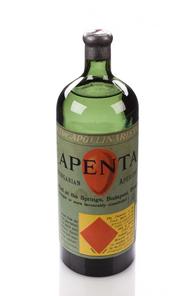





Glass specimen jar, containing gum ghatti (anogeissus latifola wall.), India, 1830-1930
Gum ghatti (anogeissus latifola) is used in ancient medical traditions. These include Ayurveda and Unani Tibb. The plant helps treat diarrhoea, dysentery and ulcers. It has cooling and astringent (tissue-contracting) properties. The latter helps reduce blood loss. Recent research shows the plant also treats skin wounds. The plant shown on the far left in its form of gum resin is also used as a food stabiliser. The seeds are shown with two medicinal plants: ajwain seeds (A671108) and areca nuts (A669305).
Details
- Category:
- Materia Medica & Pharmacology
- Collection:
- Sir Henry Wellcome's Museum Collection
- Object Number:
- A669306
- Materials:
- glass
- Measurements:
-
overall: 154 mm x 80 mm, .51kg
- type:
- sample




